Posts Tagged ‘Spirea’
Mid July Flowers
Posted in Nature, Wildflowers, tagged Arrowleaf Tearthumb, Ashuelot River, Asiatic Dayflower, Canada Thistle, Canon EOS Rebel T6, Common Elderberry, Creeping Bellflower, Deptford Pink, Goldenrod, Horse Nettle, Keene, Long Leaf Speedwell, Meadowsweet, Motherwort, Native Plants, Nature, New Hampshire, NH, Northern Maleberry, Olympus Stylus TG-870, Purple Flowering Raspberry, Spirea, Spreading Dogbane, Summer Wildflowers, Swanzey New Hampshire on July 27, 2019| 24 Comments »
Summer has always been good to me, even the bittersweet end, with the slanted yellow light.
From The Garden
Posted in Nature, tagged Allium, Daylily, False Indigo, False Spirea, Foxglove, Gardening, Keene, Monkshood, New Hampshire, Painted Daisy, Shasta Daisy, Spirea, Summer Flowers, Sunflower, Yarrow on June 30, 2012| 13 Comments »
Flowers, both wild and cultivated, are everywhere you look right now. Since I’ve never met a flower that I didn’t like, I like to occasionally show a few garden flowers on this blog along with the wildflowers and other bits of nature. After all, all flowers were once wild.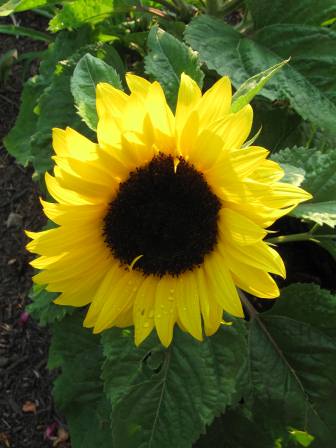 I found this strange dwarf sunflower (Helianthus) plant in a local park. The thing that made it so strange, I thought, were the large flowers on such a small plant. They had to have been the size of a small dinner plate and looked odd on a plant only 18 inches tall. But that’s just my opinion and in any case, they were very beautiful flowers.
I found this strange dwarf sunflower (Helianthus) plant in a local park. The thing that made it so strange, I thought, were the large flowers on such a small plant. They had to have been the size of a small dinner plate and looked odd on a plant only 18 inches tall. But that’s just my opinion and in any case, they were very beautiful flowers. 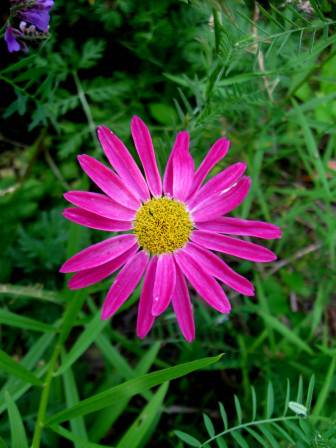 A longtime garden favorite of mine is the painted daisy (Chrysanthemum coccineum.) This plant is in the Chrysanthemum family and is also called pyrethrum. Gardeners may recognize the word pyrethrum from the natural insect sprays that are made from this plant. Pyrethrum has been used as an insecticide for centuries and is still used today by people not wanting to use chemical pesticides. One of these grew in my garden for many years but I think the recent unusually warm winter was too much for it since it never came up this spring. The plant pictured grows at a local school.
A longtime garden favorite of mine is the painted daisy (Chrysanthemum coccineum.) This plant is in the Chrysanthemum family and is also called pyrethrum. Gardeners may recognize the word pyrethrum from the natural insect sprays that are made from this plant. Pyrethrum has been used as an insecticide for centuries and is still used today by people not wanting to use chemical pesticides. One of these grew in my garden for many years but I think the recent unusually warm winter was too much for it since it never came up this spring. The plant pictured grows at a local school. 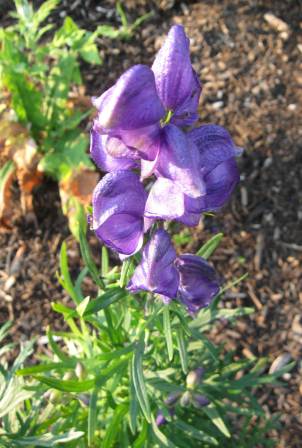 The hood shaped upper petal of a monkshood (Aconitum) flower helps to easily identify it. I found this one growing in a local children’s park, which is disturbing since Aconite, which monkshood is, is one of the most poisonous plants known. In fact, some species of aconite are so poisonous that their aconitine toxin can easily be absorbed through the skin while picking their leaves. Aconite is also called wolf’s bane, leopard’s bane, and Friar’s cap. People who have mistaken its roots for horseradish have died 4-6 hours after eating them. This plant has been known medicinally for centuries and has long been used to poison arrows and spears. Children should always be warned about its dangers.
The hood shaped upper petal of a monkshood (Aconitum) flower helps to easily identify it. I found this one growing in a local children’s park, which is disturbing since Aconite, which monkshood is, is one of the most poisonous plants known. In fact, some species of aconite are so poisonous that their aconitine toxin can easily be absorbed through the skin while picking their leaves. Aconite is also called wolf’s bane, leopard’s bane, and Friar’s cap. People who have mistaken its roots for horseradish have died 4-6 hours after eating them. This plant has been known medicinally for centuries and has long been used to poison arrows and spears. Children should always be warned about its dangers. 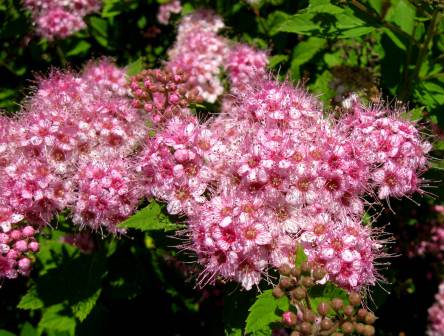 Spirea (Spiraea ) is a very common shrub often seen planted in store and bank parking lots because it needs very little care. The old fashioned white varieties were called bridal wreath but now many hybrids exist and usually have white to pink flowers. However, some I’ve seen look almost neon blue, so plant breeders are still working on it. The plant pictured was a very low growing dwarf that was absolutely covered with mounds of pink flowers. I found it growing in a store parking lot.
Spirea (Spiraea ) is a very common shrub often seen planted in store and bank parking lots because it needs very little care. The old fashioned white varieties were called bridal wreath but now many hybrids exist and usually have white to pink flowers. However, some I’ve seen look almost neon blue, so plant breeders are still working on it. The plant pictured was a very low growing dwarf that was absolutely covered with mounds of pink flowers. I found it growing in a store parking lot. 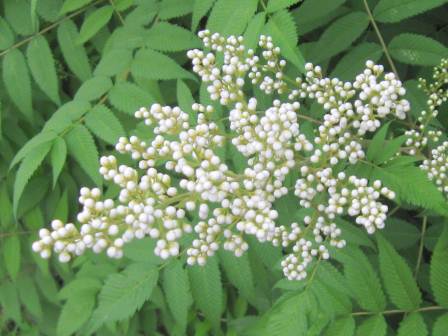 This plant fools a lot of people because the leaves look a lot like sumac leaves. Then the flower buds appear and it’s clear that it isn’t sumac, but what is it? Its name is false spirea (Sorbaria sorbifolia.) If you look at the spirea plant in the previous photo you’ll see small round, pink flower buds. The false spirea has small, round, white flower buds and when they open like in the photo below the flowers look almost like those of spirea.
This plant fools a lot of people because the leaves look a lot like sumac leaves. Then the flower buds appear and it’s clear that it isn’t sumac, but what is it? Its name is false spirea (Sorbaria sorbifolia.) If you look at the spirea plant in the previous photo you’ll see small round, pink flower buds. The false spirea has small, round, white flower buds and when they open like in the photo below the flowers look almost like those of spirea. 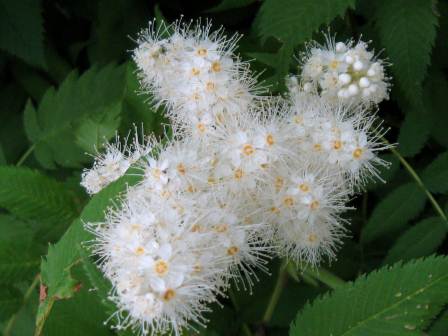 The beautiful plumes of false spirea (Sorbaria sorbifolia) flowers cover this small shrub that looks much like stag horn sumac. Its round white buds and long stamens on the flowers point to it being something very different than sumac though.
The beautiful plumes of false spirea (Sorbaria sorbifolia) flowers cover this small shrub that looks much like stag horn sumac. Its round white buds and long stamens on the flowers point to it being something very different than sumac though. 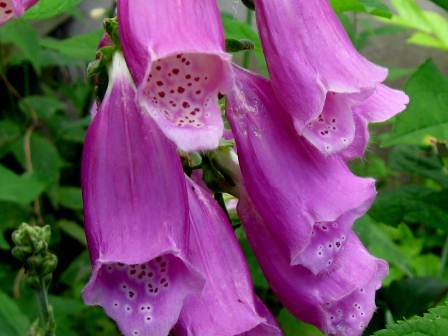 Common foxglove (Digitalis purpurea ) blooms in my yard wherever it happens to grow because it self-sows so easily. Since I no longer have small children I don’t have to worry, but this is another plant that children should be warned away from. The heart medicine digitalis was originally made from plants in this family. All parts of the plant are poisonous and people who have mistaken the leaves for those of comfrey have died. One half of a gram of dried seed is deadly. Other names for foxglove are witches’ gloves, dead men’s bells, thimbles, fairy cap, fairy glove, fairy thimbles, fairy finger, fairy bells, dog’s-finger, finger flower, lady’s-glove, lady’s-finger, lady ‘s-thimble, popdock, flapdock, flopdock, lion’s-mouth, rabbit’s-flower, cottagers, throatwort, Scotch mercury, bloody fingers, and virgin’s glove. The plant is originally from Europe and has been used medicinally for centuries. In old England picking foxgloves was unlucky, and its blooms were absolutely forbidden inside because it was believed that they gave witches and / or Beelzebub access to the house.
Common foxglove (Digitalis purpurea ) blooms in my yard wherever it happens to grow because it self-sows so easily. Since I no longer have small children I don’t have to worry, but this is another plant that children should be warned away from. The heart medicine digitalis was originally made from plants in this family. All parts of the plant are poisonous and people who have mistaken the leaves for those of comfrey have died. One half of a gram of dried seed is deadly. Other names for foxglove are witches’ gloves, dead men’s bells, thimbles, fairy cap, fairy glove, fairy thimbles, fairy finger, fairy bells, dog’s-finger, finger flower, lady’s-glove, lady’s-finger, lady ‘s-thimble, popdock, flapdock, flopdock, lion’s-mouth, rabbit’s-flower, cottagers, throatwort, Scotch mercury, bloody fingers, and virgin’s glove. The plant is originally from Europe and has been used medicinally for centuries. In old England picking foxgloves was unlucky, and its blooms were absolutely forbidden inside because it was believed that they gave witches and / or Beelzebub access to the house. 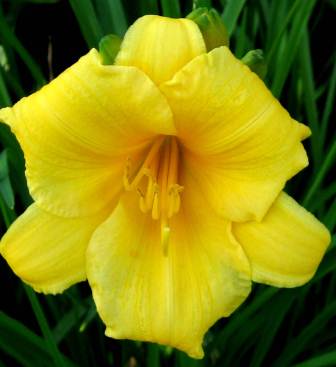 This blossom is probably seen coast to coast, because it is the very popular Stella d’ Oro daylily (Hemerocallis.) The reason this plant is so popular is because it was one of the first “ever blooming” day lilies. The dwarf plant has flowers that only last a day like any daylily but there are so many of them that it blooms for months and will often be the latest blooming daylily in a flower bed. This plant was developed in 1975 and is still seen all along city streets and in commercial parking lots. This one grows at a local bank.
This blossom is probably seen coast to coast, because it is the very popular Stella d’ Oro daylily (Hemerocallis.) The reason this plant is so popular is because it was one of the first “ever blooming” day lilies. The dwarf plant has flowers that only last a day like any daylily but there are so many of them that it blooms for months and will often be the latest blooming daylily in a flower bed. This plant was developed in 1975 and is still seen all along city streets and in commercial parking lots. This one grows at a local bank. 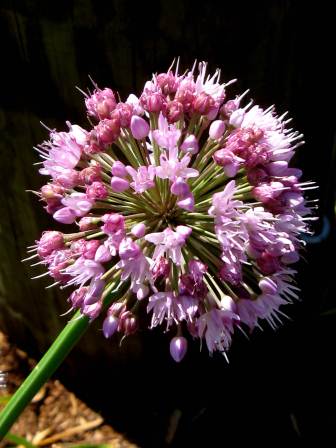 Also growing at the same bank as the Stella d’ Oro daylily were large beds of ornamental flowering onion (Allium.) Alliums are useful bulbs that are a bridge between spring and summer flowering bulbs. The globular heads of star shaped flowers come in pink, white, blue, purple, and rarely yellow. These plants aren’t common but they should be used more than they are because they will bloom for a month or more.
Also growing at the same bank as the Stella d’ Oro daylily were large beds of ornamental flowering onion (Allium.) Alliums are useful bulbs that are a bridge between spring and summer flowering bulbs. The globular heads of star shaped flowers come in pink, white, blue, purple, and rarely yellow. These plants aren’t common but they should be used more than they are because they will bloom for a month or more. 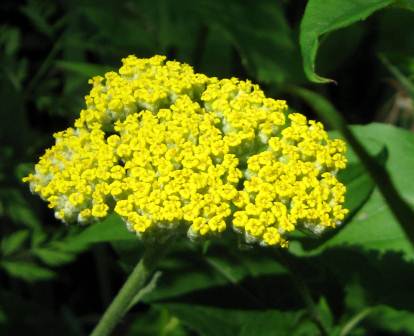 The flat topped flowers and feathery leaves of the common white roadside yarrow (achillea) are repeated in garden yarrow. The major difference is color and size of bloom; garden yarrow can be pink, yellow, white, red, and even apricot and the flowers are generally much larger than common yarrow. Yarrow is a native plant that is useful in sunny, dry spots in the garden. Its flower heads retain their color well when dried.
The flat topped flowers and feathery leaves of the common white roadside yarrow (achillea) are repeated in garden yarrow. The major difference is color and size of bloom; garden yarrow can be pink, yellow, white, red, and even apricot and the flowers are generally much larger than common yarrow. Yarrow is a native plant that is useful in sunny, dry spots in the garden. Its flower heads retain their color well when dried.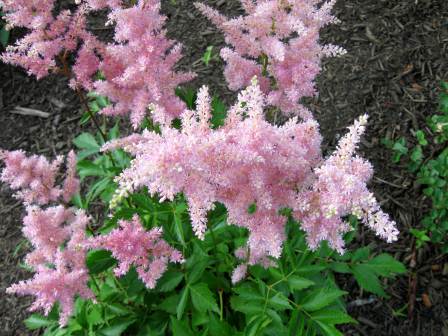 Astilbe (Astilbe ) (pronounced ah-still-bee) is a perennial that doesn’t need fussing over. I planted several in my yard years ago and have hardly touched them since. I like the unusual feathery flower heads. I grow white, pink and red varieties, which is the extent of their color range. They are excellent for semi shade areas and look good planted alongside ferns and hostas. These flowers also dry well and will hold their color for months.
Astilbe (Astilbe ) (pronounced ah-still-bee) is a perennial that doesn’t need fussing over. I planted several in my yard years ago and have hardly touched them since. I like the unusual feathery flower heads. I grow white, pink and red varieties, which is the extent of their color range. They are excellent for semi shade areas and look good planted alongside ferns and hostas. These flowers also dry well and will hold their color for months.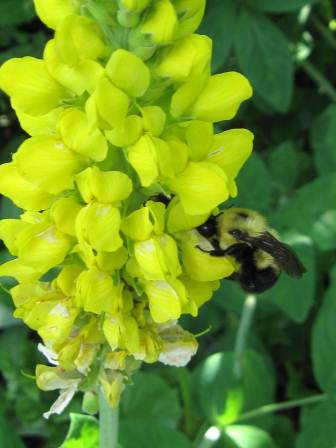 Since Indigo is the color of a blue dye it seems strange to name a plant Yellow false indigo, but here it is. False indigo (Baptisa) is a shrub-like perennial with blue, purple, and even yellow flowers that resemble pea blossoms. This is a very tough, 3-4 foot tall plant that can stand a lot of dryness. As the photo shows, bumble bees love it. I found this example in a local park.
Since Indigo is the color of a blue dye it seems strange to name a plant Yellow false indigo, but here it is. False indigo (Baptisa) is a shrub-like perennial with blue, purple, and even yellow flowers that resemble pea blossoms. This is a very tough, 3-4 foot tall plant that can stand a lot of dryness. As the photo shows, bumble bees love it. I found this example in a local park. 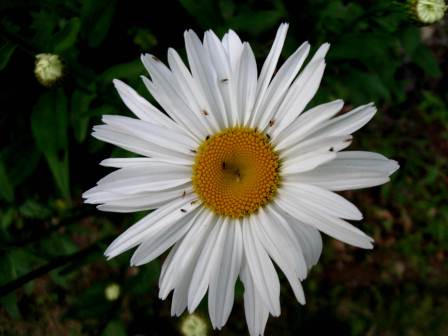 This Shasta daisy (Chrysanthemum maximum) that I grow had tiny little flies all over it the day that I took this picture. I don’t know what they were and I’ve never noticed them on the plant before. The Shasta daisy was developed by plant breeder Luther Burbank over 100 years ago and was named for the white snow of Mount Shasta. These plants are a hybrid cross of the common roadside ox-eye daisy and an English field daisy called Leucanthemum maximum. They are one of the easiest perennials to grow and, other than weeding, need virtually no care. Dwarf varieties are less apt to have their stems bent over by heavy rains.
This Shasta daisy (Chrysanthemum maximum) that I grow had tiny little flies all over it the day that I took this picture. I don’t know what they were and I’ve never noticed them on the plant before. The Shasta daisy was developed by plant breeder Luther Burbank over 100 years ago and was named for the white snow of Mount Shasta. These plants are a hybrid cross of the common roadside ox-eye daisy and an English field daisy called Leucanthemum maximum. They are one of the easiest perennials to grow and, other than weeding, need virtually no care. Dwarf varieties are less apt to have their stems bent over by heavy rains.
Nature is painting for us, day after day, pictures of infinite beauty, if only we have the eyes to see them. ~John Ruskin
I hope you enjoyed a small glimpse of what New Hampshire flower gardens have to offer. Thanks for stopping in.





















